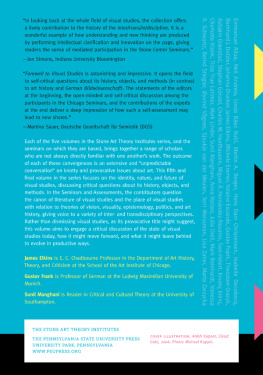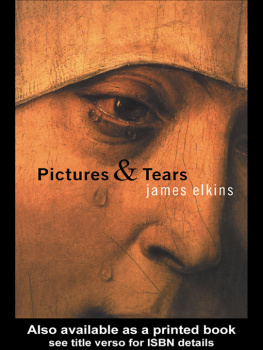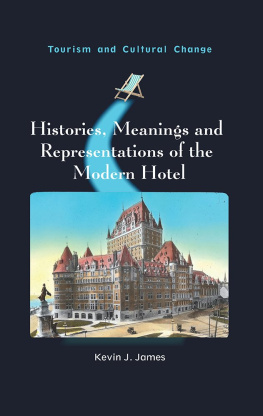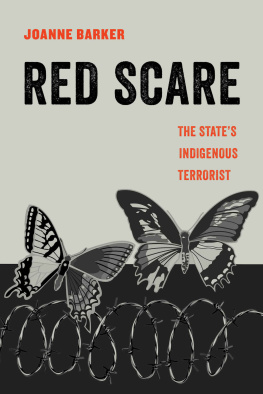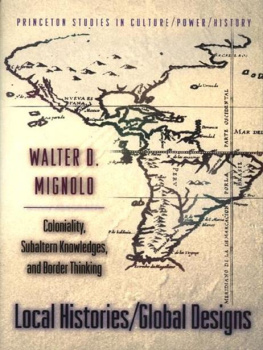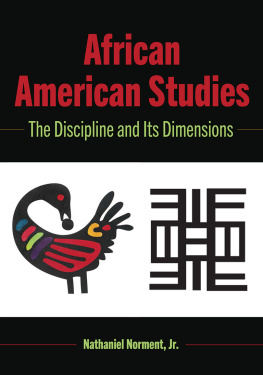Farewell to Visual Studies
THE STONE ART THEORY INSTITUTES
Edited by James Elkins
VOL. 1
ART AND GLOBALIZATION
VOL. 2
WHAT IS AN IMAGE?
VOL. 3
WHAT DO ARTISTS KNOW?
VOL. 4
BEYOND THE AESTHETIC AND THE ANTI-AESTHETIC
VOL. 5
FAREWELL TO VISUAL STUDIES
The Stone Art Theory Institutes is a series of books on five of the principal unresolved problems in contemporary art theory. The series attempts to be as international, inclusive, and conversational as possible in order to give a comprehensive sense of the state of thinking on each issue. All together, the series involves more than three hundred scholars from more than sixty countries.
This series is dedicated to Howard and Donna Stone, longtime friends of the School of the Art Institute of Chicago.
Farewell to Visual Studies

The Stone Art Theory Institutes Volume 5
Edited by James Elkins, Sunil Manghani, and Gustav Frank
The Pennsylvania State University Press
University Park, Pennsylvania
Library of Congress
Cataloging-in-Publication Data
Farewell to visual studies / edited by James Elkins, Sunil Manghani, and Gustav Frank.
pagescm(The Stone art theory institutes ; volume 5)
Summary: A transdisciplinary collection of essays discussing the identity, nature, and future of visual studies as a laboratory for thinking about relations between fields including art history, cultural studies, sociology, visual anthropology, film studies, media studies, postcolonial studies, philosophy of history, the science of vision, and science studiesProvided by publisher.
Includes bibliographical references and index.
ISBN 978-0-271-07077-3 (cloth : alk. paper)
1. Art and society.
2. Culture.
3. Visual communication.
I. Elkins, James, 1955 , editor. II. Manghani, Sunil, editor. III. Frank, Gustav, editor. IV. Series: Stone art theory institutes (Series) ; v. 5.
N 72. S 6 F 37 2015
701.03dc23 2015019619
Copyright 2015
The Pennsylvania State University
All rights reserved
Printed in the United States of America
Published by
The Pennsylvania State University Press,
University Park, PA 16802-1003
The Pennsylvania State University Press
is a member of the
Association of American University Presses.
It is the policy of The Pennsylvania State University Press to
use acid-free paper. Publications on uncoated stock satisfy
the minimum requirements of American National Standard
for Information SciencesPermanence of Paper for
Printed Library Material, ansi z39.481992.
This series is dedicated to Howard and Donna Stone, longtime friends of the School of the Art Institute of Chicago.
CONTENTS
Introductions
First Introduction: Starting Points
James Elkins
Second Introduction: Affect, Agency, and Aporia: An Indiscipline with Endemic Ambivalences and a Lack of Pictures
Gustav Frank
Third Introduction: Visual Studies, or, This is Not a Diagram
Sunil Manghani
In the usual course of things, art theory happens invisibly, without attracting attention. Concepts like picture, visual art, and realism circulate in newspapers, galleries, and museums as if they were as obvious and natural as words like dog, cat, and goldfish. Art theory is the air the art world breathes, and it is breathed carelessly, without thought. It is the formless stuff out of which so many justifications are conjured. Art theory also happens in universities and art schools, where it is studied and nurtured like a rare orchid. And art theory happens in innumerable academic conferences, which are sometimes studded with insights but are more often provisional and inconclusive. In those academic settings, words like picture, visual art, and realism are treated like impossibly complicated machines whose workings can hardly be understood. Sometimes, then, what counts as art theory is simple and normal, and other times it seems to be the most difficult subject in visual art.
A similarity links these different ways of using theory. In the art world as in academia, it often feels right just to allude to an concept like picture, and let its flavor seep into the surrounding conversation. That is strange because picture is so important to so many people, and it leads to wayward conversations. The books in this series are intended to push hard on that strangeness, by spending as much time as necessary on individual concepts and the texts that exemplify them. Some books are more or less dedicated to particular words: volume 1 focuses on globalization, translation, governmentality, and hybridity; volume 2 explores image, picture, and icon. Volume 3 is concerned with the idea that art is research, which produces knowledge. Volume 4 is about the aesthetic, the anti-aesthetic, and the political; and volume 5 concentrates on visual studies, visual culture, and visuality. This series is like an interminable conversation around a dictionaryor like the worlds most prolix glossary of art. That isnt to say that the purpose of these conversations is to fix meanings: on the contrary, the idea is to work hard enough so that what seemed obdurate and slippery, as Wittgenstein said, begins to fracture and crack.
Each book in this series started as a week-long event, held in Chicago. No papers were given (except as evening lectures, which are not recorded in these books). For a week, five faculty and a group of twenty-five scholars met in closed seminars. In preparation for the week they had read over eight hundred pages of assigned texts. The week opened with a three hour panel discussion among the faculty, continued with four and a half days of seminars (six hours each day), and ended with a five hour panel discussion. All thirty-five hours of it was taped and edited, and the pertinent portions are presented here.
This series is a refinement of a previous book series called
The Introduction to each volume is meant as a straightforward and clear review of the critical situation leading up to the seminars. The Art Seminar books then had a set of essays to help set the stage for the transcribed discussions. There are no essays in this series, because it is not possible to usefully condense the hundreds of pages of texts that informed these discussions. (References can be found in the transcripts.) The omission of essays makes this series more difficult than The Art Seminar, but the literature of art theory has grown beyond the point where it can be helpfully anthologized. The books in this series are not introductions to the various subjects they treat, but attempts to move forward given the current state of discourse in each field. In that they follow the lead of the sciences, where more advanced textbooks necessarily presuppose more introductory material.
After each years week-long event, the editors selected excerpts from the thirty-five hours of audio tapes and and produced a rough-edited transcript. It was given to each of the participants, who were invited to edit their contributions and add references. After several rounds of editing the transcript was sent out to forty or fifty people who did not attend the event. They were asked to write assessments, which appear here in the order they were received. The assessors were asked to consider the conversation from a distance, noting its strengths and its blind spots, in any style and at any length. As the assessments came in, they were distributed to people who hadnt yet completed theirs, so that later assessments often comment on earlier ones, building an intermittent conversation through the book.

